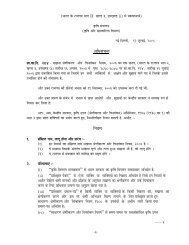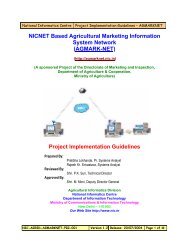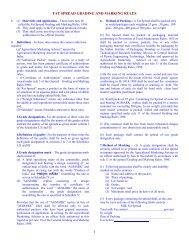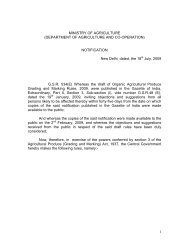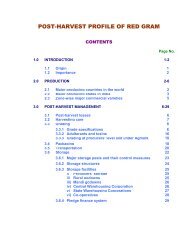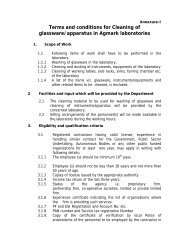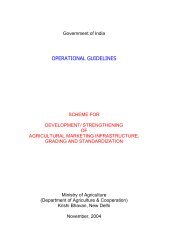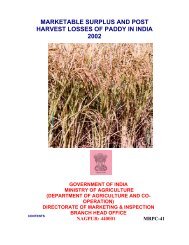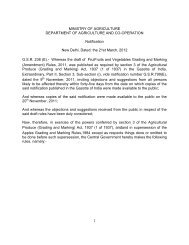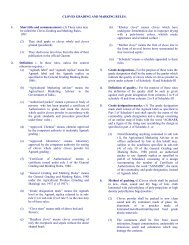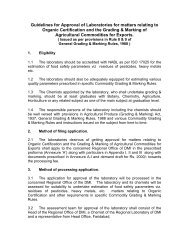Post - Harvest Management of Mushrooms with Special ... - Agmarknet
Post - Harvest Management of Mushrooms with Special ... - Agmarknet
Post - Harvest Management of Mushrooms with Special ... - Agmarknet
Create successful ePaper yourself
Turn your PDF publications into a flip-book with our unique Google optimized e-Paper software.
5) Drying techniques for export <strong>of</strong> wild growing mushrooms have not made<br />
any adjustment to export market. People engaged in collection <strong>of</strong> wild<br />
mushrooms may properly be educate/trained.<br />
6) Lack <strong>of</strong> market/consumer acceptability for new mushroom varieties in<br />
domestic market and its potential in export market. Varieties other than<br />
white button mushroom are to be cultivated. Growers <strong>of</strong> Himachal<br />
Pradesh state should avail the advantage <strong>of</strong> favourable agro-climatic<br />
conditions <strong>of</strong> the state and exploit the potentials <strong>of</strong> other fast growing<br />
mushroom varieties instead <strong>of</strong> concentrating on white button mushroom<br />
only. Price incentives may also be given for cultivation <strong>of</strong> varieties other<br />
than white button mushroom. Growers <strong>of</strong> tropical/sub tropical climate<br />
area may grow paddy straw mushrooms (Valvariella spp.), oyster<br />
mushroom (Pleurotus spp.) as these require less monetary inputs <strong>with</strong><br />
simpler production technology.<br />
GROWERS :<br />
1) Mushroom cultivators are unorganized. Hence due to low operating level<br />
they suffer <strong>with</strong> high cost for electricity, temperature, humidity<br />
conditions and transportation, lack <strong>of</strong> financial resources and technical<br />
inputs. Growers should unite to form cooperatives; S.H.Gs or some<br />
NGOs/traders should come forward to their rescue <strong>with</strong> contract farming<br />
or backward linkage arrangement. The cheaper and locally available raw<br />
materials (saw dust etc.) should be tested to utilise them as substrates.<br />
Separate facilities complete in all respects and having strong R&D<br />
laboratories should be made available for manufacture <strong>of</strong> compost and<br />
casing soil. A technical collaboration <strong>with</strong> any established institute or<br />
reputed manufacturing unit is also advisable.<br />
2) NGOs/Traders or NRCM may supply disease resistant, high yielding<br />
varieties <strong>of</strong> superior stains and improved technologies for higher yields at<br />
no loss no pr<strong>of</strong>it basis. Growers should be well versed <strong>with</strong> proper<br />
cultivation technology as the productivity depends on proper monitoring<br />
and controlling the temperature, humidity and hygienic conditions.<br />
R&D institutes situated around Solan (H.P.) are capable <strong>of</strong> imparting<br />
training whose services can be availed by growers. The H.P.state /NRCM<br />
may also have collaboration <strong>with</strong> foreign institutes viz -<br />
i) IPC plant/Mushroom growers training centre and Mushroom<br />
Experimental Station at HORST, Netherlands.<br />
ii) Mushroom Research Centre at Penn State University P.A.USA .<br />
iii) Centre Technique du Champignon Tours, France etc to educate the<br />
growers regarding the requirements <strong>of</strong> foreign buyers and technologies<br />
adopted there for promotion <strong>of</strong> mushroom export from H.P .<br />
3) A number <strong>of</strong> insects, nematodes and parasites affect the production.<br />
Complete hygienic conditions, by use <strong>of</strong> chemicals like 5% centrabride<br />
formaline, 0.05% melathion or 0.03% Newran is needed to be<br />
maintained.<br />
9




